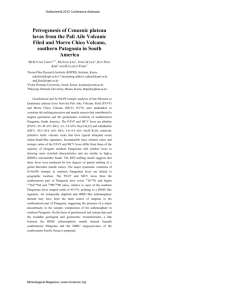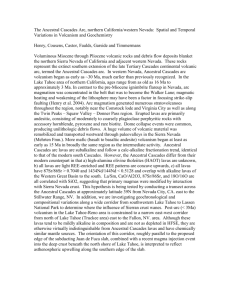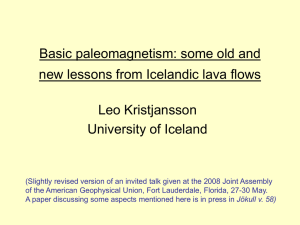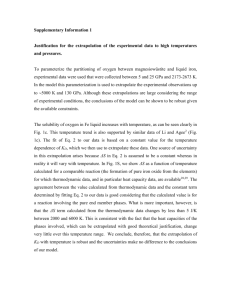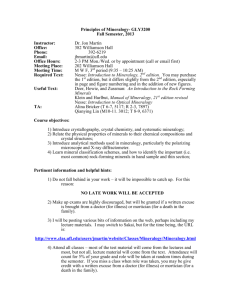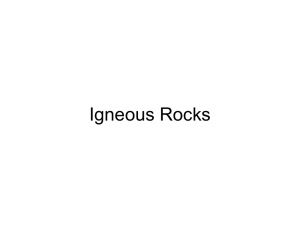Handout 3 - Cloudfront.net
advertisement
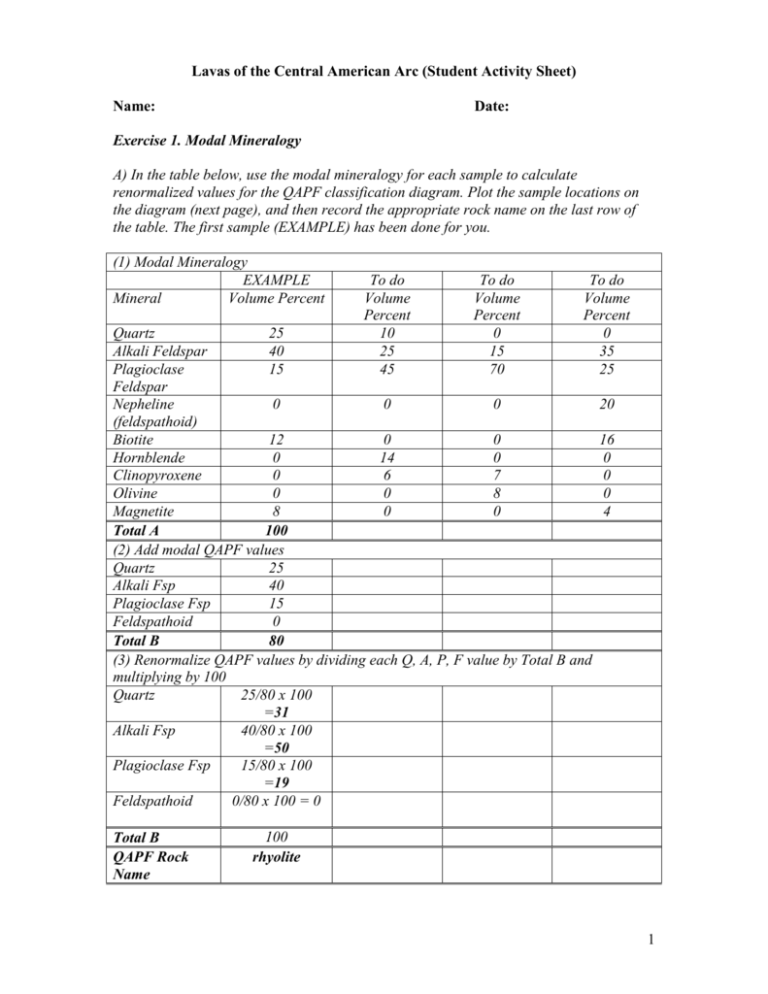
Lavas of the Central American Arc (Student Activity Sheet) Name: Date: Exercise 1. Modal Mineralogy A) In the table below, use the modal mineralogy for each sample to calculate renormalized values for the QAPF classification diagram. Plot the sample locations on the diagram (next page), and then record the appropriate rock name on the last row of the table. The first sample (EXAMPLE) has been done for you. (1) Modal Mineralogy EXAMPLE Mineral Volume Percent To do Volume Percent 10 25 45 To do Volume Percent 0 15 70 To do Volume Percent 0 35 25 Quartz 25 Alkali Feldspar 40 Plagioclase 15 Feldspar Nepheline 0 0 0 (feldspathoid) Biotite 12 0 0 Hornblende 0 14 0 Clinopyroxene 0 6 7 Olivine 0 0 8 Magnetite 8 0 0 Total A 100 (2) Add modal QAPF values Quartz 25 Alkali Fsp 40 Plagioclase Fsp 15 Feldspathoid 0 Total B 80 (3) Renormalize QAPF values by dividing each Q, A, P, F value by Total B and multiplying by 100 Quartz 25/80 x 100 =31 Alkali Fsp 40/80 x 100 =50 Plagioclase Fsp 15/80 x 100 =19 Feldspathoid 0/80 x 100 = 0 Total B QAPF Rock Name 20 16 0 0 0 4 100 rhyolite 1 Lavas of the Central American Arc (Student Activity Sheet) B) Examine the image of the CAVA lava CN-4 (Fig. 11 left, below), and then estimate the modal mineralogy for the sample and record in the table below. Renormalize and classify based on the QAPF diagram and record the rock name below. Mode of CAVA lava Mineral Volume Percent Quartz Alkali Feldspar Plagioclase Feldspar Nepheline (feldspathoid) Biotite Hornblende Clinopyroxene Olivine Magnetite Total A Quartz Alkali Fsp Plagioclase Fsp Feldspathoid Total B Alkali Fsp Plagioclase Fsp Feldspathoid Total B QAPF classification diagram for volcanic rocks. (Source, http://bc.outcrop.org/GEOL_B11/) QAPF Rock Name The table below lists a major element analysis for Cerro Negro sample CN-4, for which you just carried out a modal analysis, along with data for several other samples. 2 Lavas of the Central American Arc (Student Activity Sheet) Exercise 2. Major Element Chemical Analysis A) In the table below, calculate the Y-axis values (Na2O + K2O) needed to classify each geochemical analysis on the Total Alkalies versus Silica (TAS) diagram provided below. Plot each point on the diagram below. The first sample (CN-4) has been done for you. Recall: a good analysis must have a total between 98 and 102 wt. %. Write the name of the rock at the bottom of the table. Oxide (wt. %) CN-4 CN-6 IL-4 IL-5 IL-1 SiO2 48.6 50.4 58.21 66.8 70.6 TiO2 0.65 0.83 0.66 0.4 0.25 Al2O3 14.4 20.0 17.6 15.7 14.9 FeO (total) 11.0 9.6 6.45 3.76 2.00 MnO 0.2 0.18 0.14 0.08 0.12 MgO 9.97 3.69 3.34 1.5 0.68 CaO 11.3 11.4 7.62 4.17 2.89 Na2O 1.78 2.38 3.43 4.28 4.14 K2 O 0.35 0.47 1.12 1.99 2.3 P2O5 0.06 0.32 0.23 0.27 0.17 LOI 0.08 0.10 0.35 0.42 1.97 Total 98.39 Good Analysis? yes Na2O + K2O = 2.13 Rock Name basalt Total alkalies – silica (TAS) diagram for volcanic rocks. Red dot is sample CN-4. 3 Lavas of the Central American Arc (Student Activity Sheet) B) Calculate the Mg# for each sample assuming all of the Fe is Fe2+. Then, split the FeO (total) into Fe3+ and Fe2+ assuming that 25 % of the FeO total is actually Fe2O3 and the rest is FeO (intermediate range from Kelly and Cottrell 2009.) [NOTE: due to differing molecule weights, 0.9 x wt. % Fe2O3 = wt. % FeO – make sure to use this conversion AFTER partitioning Fe3+ and Fe2+ to calculate the wt. % FeO]. Now recalculate the Mg# for each sample, and determine whether it is likely to be an unfractionated, primitive mantle melt, or not (if not primitive, it may be a melt that has either been fractionated or was generated by melting the crust). Oxide (wt. %) CN-4 CN-6 IL-4 SiO2 48.6 50.4 58.21 TiO2 0.65 0.83 0.66 Al2O3 14.4 20.0 17.6 FeO (total) 11.0 9.6 6.45 MnO 0.2 0.18 0.14 MgO 9.97 3.69 3.34 CaO 11.3 11.4 7.62 Na2O 1.78 2.38 3.43 K2 O 0.35 0.47 1.12 P2O5 0.06 0.32 0.23 LOI 0.08 0.10 0.35 (1) Calculate Mg# assuming FeO (total) is all Fe2+ Mg# IL-5 66.8 0.4 15.7 3.76 0.08 1.5 4.17 4.28 1.99 0.27 0.42 IL-1 70.6 0.25 14.9 2.00 0.12 0.68 2.89 4.14 2.3 0.17 1.97 61.76 (2) Recalculate FeO and Fe2O3 assuming that Fe2O3 is equal to 25 percent of FeO total Fe2O3 3.06 FeO 8.25 (3) Recalculate Mg# using recalculated FeO Mg# Is sample likely to be primitive mantle melt (Mg# > 65)? 68.29 yes 4 Lavas of the Central American Arc (Student Activity Sheet) Exercise 3. Calculating normative mineralogies Calculate the normative mineralogy for each of the samples in the table below using either the spreadsheet from http://minerva.union.edu/hollochk/c_petrology/norms.htm, or by making your own spreadsheet to complete the step-by-step calculations. Assume Fe 3+ = 25% of the total reported Fe. Oxide (wt. %) SiO2 TiO2 Al2O3 FeO (total) MnO MgO CaO Na2O K2 O P2O5 LOI Total CN-4 48.6 0.65 14.4 11.0 0.2 9.97 11.3 1.78 0.35 0.06 0.08 CN-6 50.4 0.83 20.0 9.6 0.18 3.69 11.4 2.38 0.47 0.32 0.10 IL-4 58.21 0.66 17.6 6.45 0.14 3.34 7.62 3.43 1.12 0.23 0.35 IL-5 66.8 0.4 15.7 3.76 0.08 1.5 4.17 4.28 1.99 0.27 0.42 IL-1 70.6 0.25 14.9 2.00 0.12 0.68 2.89 4.14 2.3 0.17 1.97 Recalculated Fe2O3 and FeO (remember that Fe2O3 = FeO/0.9) Fe2O3 FeO normative minerals qtz 0 pl 45.33 or 2.07 ne 0 cor 0 diop 20.44 hyp 19.93 ol 5.02 ilm 1.23 mt 4.44 ap 0.19 5 Lavas of the Central American Arc (Student Activity Sheet) Exercise 4. Application of methods to investigate petrogenesis of arc lavas A) The petrogenesis of basaltic lavas from Cerro Negro, Nicaragua CN-4 is from a lava flow that erupted from Cerro Negro in 1957-1960. Following these eruptions, the volcano was dormant for eight years until it erupted again in 1968. What happened to the magma beneath the volcano during those 8 years? In order to answer this question, we first compare the mineralogy and geochemistry of CN-6 (1968 lava) to CN-4 (1960 lava). Figure 11 shows hand specimens of these two lavas and you should be able to tell at a glance that they look different: the older lava (CN-4) has more olivine and pyroxene phenocrysts and the younger lava (CN-6) has more plagioclase phenocrysts (it is hard to distinguish different minerals in photographs so sketches of each rock photograph are included below) Figure 11. Hand specimens (above) and sketches highlighting phenocrysts (below) from two Cerro Negro lavas, erupted 8 years apart. Pl = plagioclase, Ol = olivine; Cpx = clinopyroxene. Scale bars are in mm. (Courtesy of Ben Edwards and Bob Stern) 6 Lavas of the Central American Arc (Student Activity Sheet) Carry out a modal analysis of CN-6, record your results below and give the rock a name, using the QAPF diagram below. Compare this with the mode and name given from QAPF for CN-4 (exercise 1B). What are the big differences in the modes of these two lavas? Why don’t these different-looking rocks have different names? Mode of CAVA lava Mineral Volume Percent Quartz Alkali Feldspar Plagioclase Feldspar Nepheline (feldspathoid) Biotite Hornblende Clinopyroxene Olivine Magnetite Total A Quartz Alkali Fsp Plagioclase Fsp Feldspathoid Total B Alkali Fsp Plagioclase Fsp Feldspathoid Total B QAPF classification diagram for volcanic rocks. (Source, http://bc.outcrop.org/GEOL_B11/) QAPF Rock Name Given that olivine and pyroxene are rich in Mg and that plagioclase is rich in Al, what do you predict will be the most important differences between the major element analyses of these two lavas? 7 Lavas of the Central American Arc (Student Activity Sheet) What name did you give to CN-6 based in its chemical composition in Exercise 2A, and how does that name compare to that for CN-4 determined using the TAS diagram? Which elements have higher concentrations in CN-4 than in CN-6? Can you relate the differences in concentrations to the differences in phenocryst mineralogy? What are the differences in the normative mineralogies? How do they compare to your estimated modes? Is CN-6 a primitive or a fractionated basalt? What about CN-4? With the above information, can you now tell a story about what might have happened at Cerro Negro between 1957-60 and 1968? Try to write a short, plausible explanation for whatever differences you can see between the two samples in the space below. 8 Lavas of the Central American Arc (Student Activity Sheet) B) The petrogenesis of lavas from Ilopango volcano, El Salvador In contrast to the extremely young Cerro Negro, Ilopango volcano in El Salvador has had a prolonged eruption history that has spanned hundreds of thousands of years, and a much greater variety of rock types. We will now think about why Ilopango has evolved differently than Cerro Negro by examining photographs, geochemistry and normative mineralogies for three samples (IL-1, 4, 5) for which you have already completed most of the calculations as parts of Exercises 2B and 3 above. Figure 12. Hand sample of Ilopango igneous rock (IL-4) showing hornblende (black) and plagioclase phenocrysts set in a fine-grained light grey groundmass (Courtesy of Mike Carr) 9 Lavas of the Central American Arc (Student Activity Sheet) Figure 13. Thin section view in plane-polarized light and crossed-polarized light of specimen Il4 from Ilopango. (Courtesy of Mike Carr). Write a brief description for IL-4 based on the hand sample image (Fig. 12), the photomicrographs (Fig. 13), and the calculated results for this sample from Exercises 2 and 3. Does the normative mineralogy match what is shown in the images? Explain. IL-4 Using the major element analyses listed in the table in Exercises 2 & 3, what are three major differences in chemical compositions and normative mineralogies between the three samples from Ilopango? 1) 2) 10 Lavas of the Central American Arc (Student Activity Sheet) 3) Are any of the three Ilopango samples good candidates for primitive magmas? Why or why not? Finally, write a short explanation based on your investigation of Cerro Negro and Ilopango lavas, accompanied by a sketch. Discuss any similarities and differences, and suggest some reasonable hypotheses to explain why the same Subduction Zone produces melts with such large differences in lava compositions. Sketch the likely differences of the “magma plumbing system” beneath the two volcanoes. This sketch should reflect whether you think the “big differences” between these two volcanoes happens ~100 km deep in the subduction zone or shallow, ~10 km deep in the crust of Central America. (It may be useful to know that such large compositional variations are common of lavas from convergent margins but not for lavas associated with mid-ocean spreading ridges, where felsic magmas are rare. You know that primitive (Mg# >65) basalts are generated by partial melting of the mantle but how are felsic magmas like those of Ilopango generated? Keep in mind that Ilopango volcano formed over many thousands of years and that it is characterized by a large caldera. This caldera formed above a region that collapsed. Hint: What could have happened beneath the volcano over all that time? Hint: What must have existed beneath the volcano to produce the caldera?). 11
